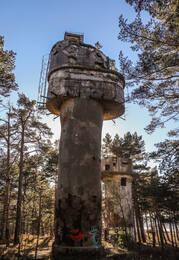Mines, bombs, torpedoes and chemical weapons in the Baltic Sea
In the early days of February 2010, news appeared on the Swedish television channel SVT that shocked and deeply surprised many.
Namely, there was a claim that the Russian army, during the withdrawal of its troops from the Baltic States in the early 1990s, had taken containers with chemical weapons and nuclear waste from the port of Liepāja and sunk them in the Baltic Sea near the island of Gotland. The Swedish government was reportedly informed about this, but this fact was kept secret... The Russian side denies this fact, while the Latvian Ministry of Defense allows the possibility that some containers with military content could have been sunk during the withdrawal of troops, although there are no concrete facts about this... Time will tell whether anyone will try to verify this information and what will happen to it all. However, from time to time, the question of weapons sunk in the Baltic Sea and the consequences of the past two World Wars and their legacy surfaces in the media throughout the Baltic Sea region.
Almost every year, large-scale mine clearance operations are carried out in the Baltic Sea, as the sea was heavily mined during both the First and Second World Wars. Russian-made anchor mines M-08, M-12, KB, German-laid magnetic bottom mines LMB, German and Russian-made torpedoes and other similar treasures are found and eliminated. Even sea mines manufactured in 1908 and 1912 are still dangerous, which fishermen still encounter and which are often found near shipping lanes, even in the Irbe Strait. According to expert calculations, there could still be about 28,000 mines and explosive objects in the sea, and about 15,000 of them are in the immediate vicinity of shipping lanes in the Irbe Strait.
However, dangerous finds can occur not only far from the coast, but also in port waters. For example, more than one mortar shell and explosive object have been found in the waters of the Liepāja port as evidence of battles that once took place here. But that's not all. After World War II, a huge amount of chemical weapons was dumped in the Baltic Sea - about 40,000 tons. They included mustard gas, the nerve gas tabun, the choking gas phosgene and arsenic-containing compounds. After the war, this chemical ammunition was dumped in large quantities near the Danish island of Bornholm, near the Swedish island of Gotland and about 100 kilometers west of Liepāja. Most likely, they were taken directly from the Liepāja port, and some of the ammunition was dumped without being taken to these dumping areas and at relatively shallow depths (only 20 meters!). There are suspicions that the ammunition, which was then buried in wooden boxes, has been exposed to currents over time and is now possibly scattered over unimaginably large areas.
There are quite contradictory opinions about the danger of this ammunition. On the one hand, there is an alarm and the mass media write about sprats in mustard gas jelly, but on the other hand, the charges fired in the Danish Straits thirty years ago were rusted and empty, no pollution has been detected nearby and it is believed that the harmful gases phosgene and tabun have degraded over time. Another thing is mustard gas, which supposedly freezes in the lower layers of water at temperatures close to zero, is harmless in this state of aggregation and cannot float. However, as early as the early nineties, fishermen from the Liepāja side have more than once pulled out such warheads with mustard gas in their nets, which have caused significant health problems, because mustard gas has warmed up and rapidly regained its toxic properties in sunlight and warm air temperatures. The first similar cases were recorded in the 1950s, and over time, fishermen have learned to avoid dangerous areas. However, how far the chemical warfare agents are actually from the port of Liepāja, we can only guess.
Let us not forget that in the Courland Cauldron at the very last moment of the war there were heavy battles and significant counter-forces and armaments were concentrated. A chemical warfare agent charge, which was suddenly found on the Klaipėda beach, decorated with the German inscription,,Yperit,,,, can serve as a serious warning. So the charge decorated with a skull contained mustard gas. People were urgently evacuated from the beach, but the charge did not cause any damage. After this incident, Lithuania reportedly made an international noise about the war agents dumped in the sea, but the scandal gradually subsided and quietly died down. On the one hand, it is believed that the Baltic Sea may become a dead sea because of these chemical charges and that all life in it may perish, that poisonous substances may cause mutations in life forms and that over time people may also suffer. In Sweden, some scientists have expressed the opinion that in recent decades the number of cancer patients has noticeably increased in the countries around the Baltic Sea and they believe that this is due to chemical warfare agents dumped in the sea, which are gradually seeping into the environment and also entering the air. Some believe that the Baltic Sea is facing the fate of another Chernobyl, others believe that the danger is greatly overestimated and therefore pretend not to see this problem.
Apollo.lv; Delfi.lv; Tvnet.lv; Leta; Kurzemes-vards.lv; Liepajniekiem.lv
Related objects
Karosta, the Military port of Liepāja (tour)
The Karosta is the largest historical military territory in the Baltics and occupies almost one third of the entire territory of Liepāja. The Karosta is a unique compound of military and fortification buildings on the shores of the Baltic Sea with a special meaning in the history and architecture of Latvia and the world. The Karosta features such military heritage sites as the North Pier and forts, the Redan, Karosta Prison, Karosta Water Tower, St. Nicholas Orthodox Maritime Cathedral, Oskars Kalpaks Bridge and others.






